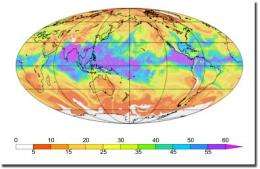Climate models confirm more moisture in atmosphere attributed to humans

(PhysOrg.com) -- When it comes to using climate models to assess the causes of the increased amount of moisture in the atmosphere, it doesn't much matter if one model is better than the other.
They all come to the same conclusion: Humans are warming the planet, and this warming is increasing the amount of water vapor in the atmosphere.
In new research appearing in the Aug. 10 online issue of the Proceedings of the National Academy of Sciences, Lawrence Livermore National Laboratory scientists and a group of international researchers found that model quality does not affect the ability to identify human effects on atmospheric water vapor.
“Climate model quality didn't make much of a difference,” said Benjamin Santer, lead author from LLNL's Program for Climate Modeling and Intercomparison. “Even with the computer models that performed relatively poorly, we could still identify a human effect on climate. It was a bit surprising. The physics that drive changes in water vapor are very simple and are reasonably well portrayed in all climate models, bad or good.”
The atmosphere's water vapor content has increased by about 0.4 kilograms per cubic meter (kg/m3) per decade since 1988, and natural variability alone can't explain this moisture change, according to Santer. “The most plausible explanation is that it's due to human-caused increases in greenhouse gases,” he said.
More water vapor - which is itself a greenhouse gas - amplifies the warming effect of increased atmospheric levels of carbon dioxide.
Previous LLNL research had shown that human-induced warming of the planet has a pronounced effect on the atmosphere's total moisture content. In that study, the researchers had used 22 different computer models to identify a human “fingerprint” pattern in satellite measurements of water vapor changes. Each model contributed equally in the fingerprint analysis. “It was a true model democracy,” Santer said. “One model, one vote.”
But in the recent study, the scientists first took each model and tested it individually, calculating 70 different measures of model performance. These “metrics” provided insights into how well the models simulated today's average climate and its seasonal changes, as well as on the size and geographical patterns of climate variability.
This information was used to divide the original 22 models into various sets of “top ten” and “bottom ten” models. “When we tried to come up with a David Letterman type 'top ten' list of models,” Santer said, “we found that it's extremely difficult to do this in practice, because each model has its own individual strengths and weaknesses.”
Then the group repeated their fingerprint analysis, but now using only “top ten” or “bottom ten” models rather than the full 22 models. They did this more than 100 times, grading and ranking the models in many different ways. In every case, a water vapor fingerprint arising from human influences could be clearly identified in the satellite data.
“One criticism of our first study was that we were only able to find a human fingerprint because we included inferior models in our analysis,” said Karl Taylor, another LLNL co-author. “We've now shown that whether we use the best or the worst models, they don't have much impact on our ability to identify a human effect on water vapor.”
This new study links LLNL's “fingerprint” research with its long-standing work in assessing climate model quality. It tackles the general question of how to make best use of the information from a large collection of models, which often perform very differently in reproducing key aspects of present-day climate. This question is not only relevant for “fingerprint” studies of the causes of recent climate change. It is also important because different climate models show different levels of future warming. Scientists and policymakers are now asking whether we should use model quality information to weight these different model projections of future climate change.
“The issue of how we are going to deal with models of very different quality will probably become much more important in the next few years, when we look at the wide range of models that are going to be used in the Fifth Assessment Report of the Intergovernmental Panel on Climate Change,” Santer said.
Provided by Lawrence Livermore National Laboratory


















